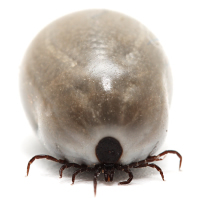 Protect your pet from ticks
Protect your pet from ticks
Australia is home to some dangerous critters, and local knowledge is key. Read below to learn about some of the parasites that could harm your pet. We recommend talking with your local Greencross Vets team to learn about the parasites that are common in your area.
We understand that choosing the right parasite prevention product can be challenging. There are lots of options to choose from and our friendly team are here to help you choose the right product for your pet and lifestyle. For example, if you have a busy lifestyle it can be easy to accidentally forget to give flea and tick prevention to your pet. Bravecto has long-lasting treatment options which are convenient and easy to use. Chat to your local vet team for more information.
Watch out for paralysis ticks
There are around 75 different species of ticks in Australia, but the most common are the brown tick and the deadly paralysis tick. The paralysis tick is by far the most dangerous parasite when it comes to your pet. It is commonly found in bushy coastal areas along the East Coast of Australia, from North Queensland to Eastern Victoria. Ticks are most prevalent from Spring to Autumn, however, can occur at any time of year. If you are travelling to a coastal area, ensure you start your pet on tick prevention before you go!
When paralysis ticks attach to our pets, they inject a neurotoxin which causes progressive paralysis, respiratory depression, and if not treated, these animals will succumb to the deadly affects of tick toxin. It is vital that you take your pet to a vet if you have found a tick.
What to do if you have found a tick on your pet?
Remove the tick immediately. Using your thumb and index fingers, gently pinch the section of your pet’s skin that the tick has attached itself to. Then get as close to the skin as possible and firmly pull the tick out of the skin. .Especially designed tick removers and tick twisters are also available to assist with this process. Don’t panic if the head of the tick remains attached to your pet; without its body, the tick is unable to inject any more toxin. Place the tick into a jar so your local vet can identify it.
Next, take your pet to the vet straight away. Even if they’re not displaying symptoms of tick paralysis, it’s important to get them checked over by a vet. The symptoms may take time to appear and by this time your pet may be showing early signs of paralysis. A quick response can make all the difference.
Tick paralysis symptoms
First signs of tick paralysis include a lack of appetite, lethargy, change in bark or meow, gagging and increasingly worse wobbliness or staggering in the back legs. As the paralysis progresses, it affects the breathing muscles and the pet’s ability to swallow. Paralysis ticks are deadly without appropriate veterinary treatment including antitoxin. The sooner vet treatment is initiated the quicker pets may be able to recover. Call your local vet immediately for advice. If your vet is closed, call an emergency vet for advice, do not wait, pets with tick paralysis can deteriorate rapidly.
- Staggered walking, difficulty jumping
- Wobbliness, especially in the hind legs
- Weakness or lethargy
- Collapse
- Vomiting, gagging or retching
- Change in bark or meow
- Difficulty breathing or increased breathing effort
Watch this video to learn how to recognise the signs of tick paralysis!
Protect your pet from ticks
It’s very important to use a tick prevention product to protect your dog or cat. Yes, cats are also susceptible to the paralysis tick and there are treatments available as there are for dogs. Some tick treatments designed for dogs may be harmful to cats, so always read the label carefully. Bravecto has an option for cats that is both safe and effective, with so many products available including tasty chews that dogs love, it’s easy to find the right solution for your pet.
Vet Tip: Learn how to do a ‘tick search’ on your pet! No treatments are 100% effective so it’s important to conduct a thorough daily tick search of your pet. Regular daily tick searches, which involve running your hands through your pet’s entire coat (including their face and ears, down the legs, paws, over their stomach, and to the tip of their tail) is recommended. To learn how to search your pet for ticks, ask your local Greencross Vets.

 Greencross Vets
Greencross Vets 










